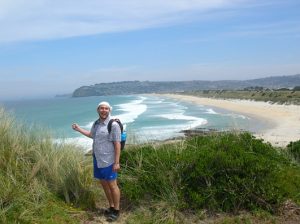Current position: Research fellow (July 2013- present) with Prof Malcolm Halcrow at Leeds University, UK
Postdoctoral fellow: at Otago University with Prof Sally Brooker (Feb 2012-June 2013)
PhD: at Loughborough University, UK, with Prof Vickie McKee (2007-2011)
MSc (Magister Inzynier): at Gdansk Technical University, Poland (2001-2006)
Photo: Dr Raf Kulmaczewski with St Kilda and St Clair beaches and the waves rolling in from the Pacific Ocean in the background (Photo by Agnes Kulmaczewski, 2013).
I arrived into Dunedin at the end of January 2012, fresh from completing my PhD and just in time for the start of ISMSC-7 which was organized by Sally. For the first three weeks I was a guest at Sally’s lovely house at the top of Pine Hill, with stunning views over the City and an amazing walk to University via the Duddingstone steps. I was introduced to ‘the steps’ by another guest at Sally’s home at that time, Prof Annie Powell, a frequent visitor to Dunedin. After the conference, Sally helped me to find a luxury house located just a 3 minute walk from the Chemistry Department and two months later my wife and daughter joined me. During our 17 month stay we did not travel a lot because I chose to be chained to my fumehood, but in any case we found some of the best of New Zealand in Dunedin itself. Dunedin is a beautiful city. It is a place where mother nature has not been “touched” by the human race, a place where mountains and ocean come together. Dunedin’s people live life at their own pace: everything seems relaxed, easygoing, and sometimes a bit like its in slow motion (perhaps that is why penguins and seals come ashore here!). One of my favorite places is the Botanic Garden which is just a 3 minute walk from University. This is a perfect place to have lunch or to gather your thoughts after a busy day in the lab. St Kilda and St Clair beaches (see picture) are wonderful for long walks and surprisingly they are not packed with people like most beaches in Europe are. At the end of the long walk along these two beaches there is a restaurant “Esplanade” where they serve probably the best garlic bread in town! Especially after a few glasses of NZ sauvignon blanc or Montieths cider.
The Chemistry department is really well equipped: the new supernova Agilent X-ray diffractometer, Bruker Mass Spec, two Agilent NMRs, TA DSC and TGA instruments, Mössbauer and finally the brilliant microanalytical lab (thanks Bob and Pauline!).
As everyone else has mentioned, Sally has an “open door” policy which basically means that you can bother her with your stuff at anytime. She acts not like a boss but more like a friend who is keen to give you helpful advice on anything.
My project was in the area of spin crossover (SCO) systems, a new area for me, so I learnt a huge amount during my time in Sally’s group, whilst also putting my synthetic skills to good use in the lab. The biggest highlight for me is definitely our publication in JACS (out online in January 2014). Gaining this SCO expertise proved invaluable career-wise too, as it led to me being offered my next postdoc, also in the SCO field, with Prof Malcolm Halcrow at Leeds, UK (2013-2018).
Now, after 6 months in Leeds, I can admit that I miss the city of Dunedin and its people. I would love to have one of my old Saturdays back, playing badminton with JVK and Tan in the morning, then playing football for 5B’s Northern AFC, having a pint of Emersons after the game and finally having a late family dinner with Sally, Annie or Don.
RAF and family


